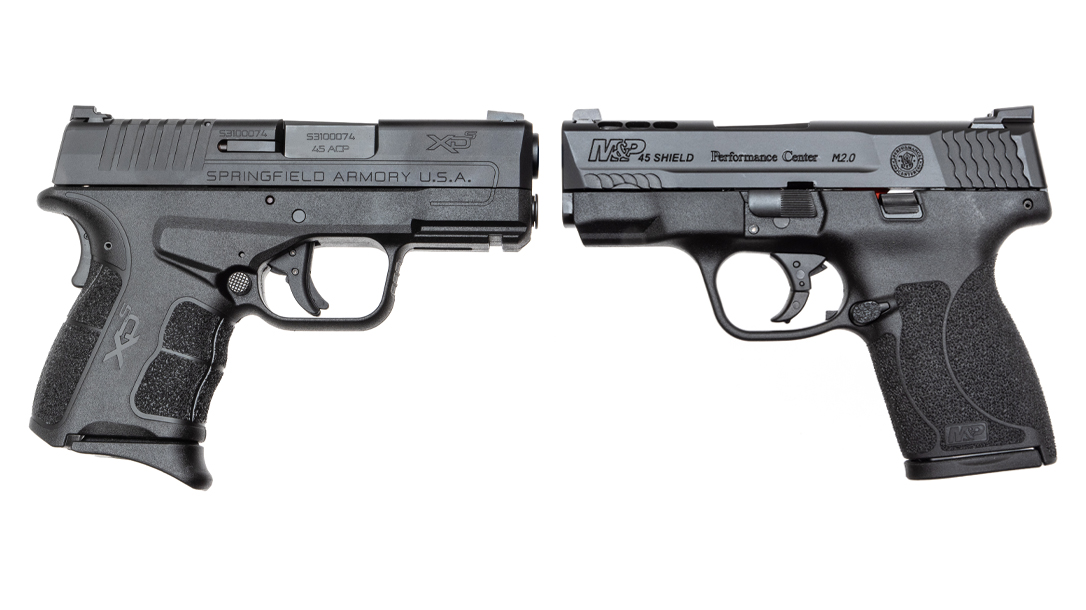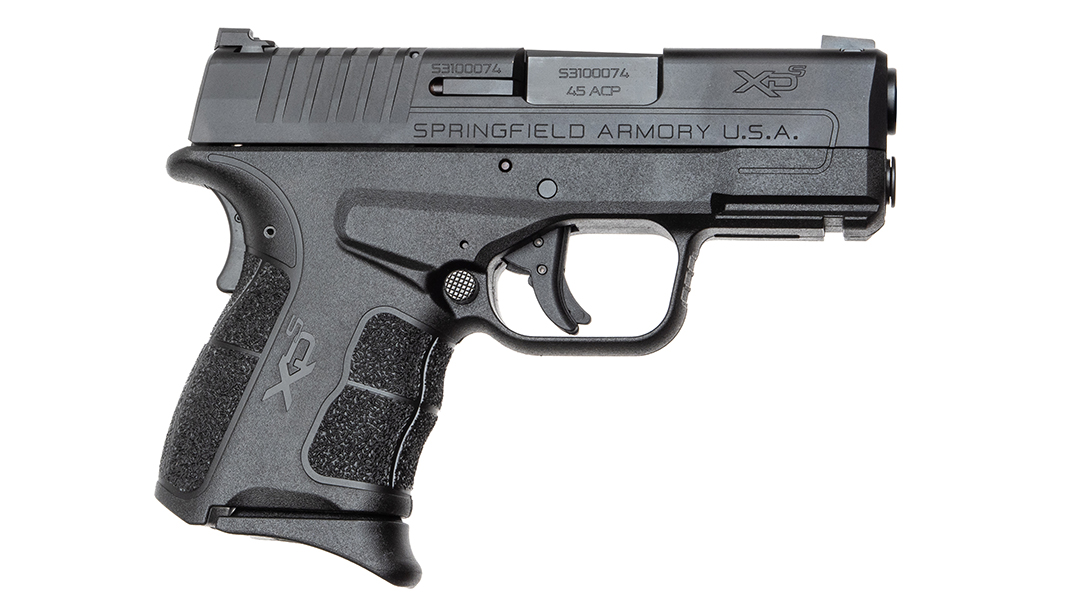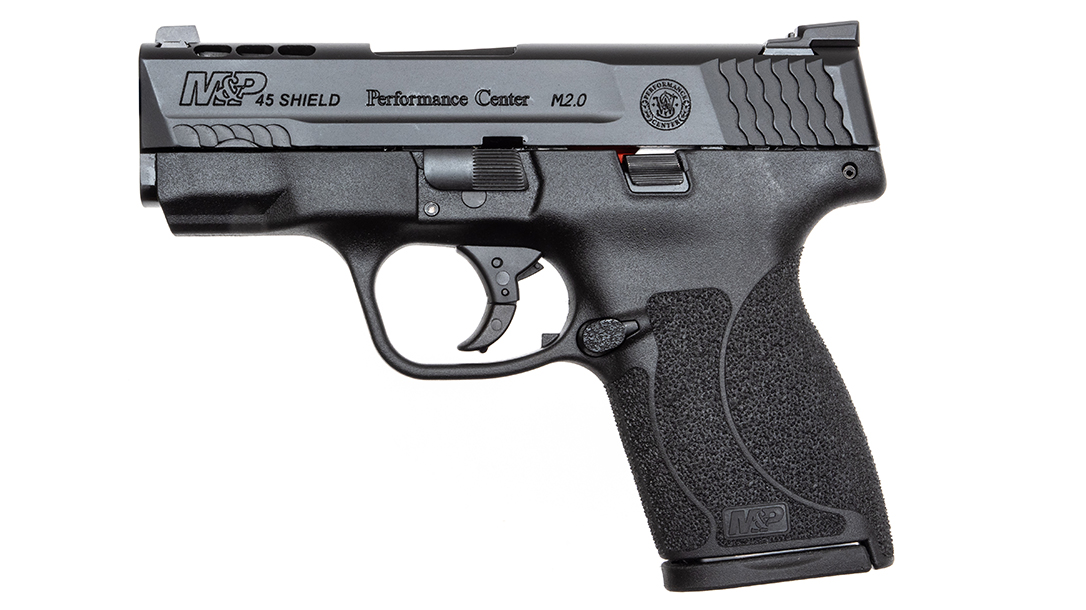It seems that 9mm is back in vogue nowadays with the deluge of subcompact 9mm carry pistols on the market. Ever since the FBI said it was OK to use the 9mm again, non-1911 pistols in .40 S&W and .45 ACP seem to be on the endangered species list—at least any new introductions. But Springfield Armory and Smith & Wesson are both keeping the faith by continuing to offer up new carry pistols in .45 ACP.
Best 45 ACP Subcompact Showdown
Recognizing the need to evolve, both companies have recently introduced second-generation models of their extremely popular concealed-carry guns. And for those folks that ate two full Hungry-Man TV dinners each night, the XD-S Mod.2 and M&P Shield M2.0 are still available in that big, fat, all-American .45 ACP cartridge that we know and love.
Xtreme Duty
Building on the success of the original XD-S, the XD-S Mod.2 is a refinement of the original concept that brings a lot more to the table. The first thing I noticed was the extremely comfortable and redesigned grip. The Mod.2’s grip angle was changed slightly to give the shooter a higher hold on the pistol. Combined with the thinner beavertail, the user’s hand gets much closer to the bore’s centerline than the original XD-S. On top of this, Springfield improved the grip texturing and rounded the backstrap for better comfort.
Advertisement — Continue Reading Below
The sight system was changed to an AmeriGlo Pro-Glo tritium front post with a high-visibility yellow circle for quick acquisitions and tracking. The steel rear sight includes a U-notch and is serrated to reduce glare. You can rack the slide with one hand by catching the rear sight on a boot, belt, table or other such object if the need should arise. Like the original XD-S, the Mod.2 has a loaded-chamber indicator as well as a grip safety to prevent accidental discharges. Additionally, the Mod.2 has an ambidextrous magazine release, though the slide catch is still located on the left side.
The Mod.2 is perfectly sized for concealed carry, despite being chambered in .45 ACP. It has an overall length of just 6.5 inches with its 3.3-inch barrel, and it tips the scales at 21.5 ounces with an empty flush-fitting magazine. It barely reaches 4.66 inches in height, and the grip frame is amazingly slim at 0.98 inches. The slide, which has a Melonite finish like the barrel, is 0.94 inches wide. It’s also worth noting that, unlike the Shield, the frame has an accessory rail, and Springfield includes a flush-fitting, five-round mag as well as an extended six-rounder.
Ported Protector
The M&P Shield series has been an extremely popular choice for concealed-carry shooters for several years now, and its popularity seems to only be increasing. For this review, I received the Ported M&P45 Shield M.20 from Smith & Wesson’s Performance Center (PC). While it may seem a little unbalanced to weigh it against a stock XD-S Mod.2, the MSRP of both pistols is within $60 of each other.
Advertisement — Continue Reading Below
The most obvious improvement between the original Shield and the M2.0 is the grip texturing, which is a little more aggressive on the new gun and digs into the hand a bit more for a better purchase. Another plus is that the magazine release is reversible rather than ambidextrous, and I see that as a positive benefit since a reverse-side release doesn’t get in the way or stiffen the mechanism.
Aside from the ported barrel, other PC features include the ledged night sights for one-handed slide manipulations. The sights are a three-dot affair with tritium inserts and white outlines. The front of the slide has mini cocking serrations that, to be honest, aren’t all that effective. The serrations at the rear, however, are aggressive and fairly deep, making them extremely effective.
Performance Center Touches
The action is tuned by the S&W PC, and the results were a little bit of a mixed bag. The actual trigger break itself was absolutely outstanding. It was quite crisp and only required an average of 3.65 pounds of pressure before it broke. The downside was the gritty pre-travel. There was some rubbing and creaking going on between the trigger safety being engaged and the trigger meeting resistance.
Advertisement — Continue Reading Below
While the same length as the XD-S Mod.2, the Shield M2.0 weighs a bit more, coming in at 22.5 ounces, and the slide is 0.97 inches thick—just a hair more than its opponent. However, the grip felt narrower in my hands and didn’t seem to fill the palm quite as ergonomically as the XD-S Mod.2.
The stainless steel slide and barrel are treated with the same corrosion-resistant Armornite finish that can be found on virtually all M&P pistols. One definite advantage of the Shield over the XD-S is that its flush-fitting magazine houses six rounds instead of five. It also comes with an extended magazine that holds seven rounds as well, though it substantially adds to the overall height.
Range Duel
When you bring two high-quality pistols together to compare features and performance, it’s always going to be the little things that push a consumer in one direction or the other. That’s because all the really important stuff is usually already squared away.
Advertisement — Continue Reading Below
For example, I tested both pistols with six different types of ammunition for this review, and I didn’t experience a single malfunction. I used various FMJ rounds Fiocchi, Sellier & Bellot and Sig Sauer as well as premium defensive loads from Hornady, Sig Sauer and Speer. The two single-stack .45s just chugged right along without a care in the world. That’s what I expect of products from top-tier companies such as these.
At first blush, the XD-S felt more comfortable in the hand. However, the ported barrel and slide on the Shield definitely made an impressive difference in terms of felt recoil. There was significantly less muzzle rise, and I didn’t feel the same jolt as when I shot the XD-S, especially with Hornady’s 220-grain +P Critical Duty ammo.
But to make things fair, I brought out my own non-ported M&P45 Shield M2.0 and compared it to the XD-S. The recoil experience was quite similar between those two. In fact, I would say the XD-S, with its more ergonomic grip, had a slight edge with porting out of the equation. The Shield’s porting does pay off exceptionally well in the recoil department, though it will cost the end-user a bit more money.
Advertisement — Continue Reading Below
Finer Points
The night sights on the Shield are very serviceable, but I strongly favored the Pro-Glo front sight on the XD-S. The bright yellow halo on the front post was a stark contrast to the all-black, serrated rear sight. That made it very fast to pick up, and it fit beautifully into the U-notch of the rear sight for a quick and easy sight picture.
Each pistol had a few quirks, too. The ambidextrous magazine release on the XD-S was stiff with a sluggish return. The Shield’s magazine release was easier to use and more responsive, ejecting spent magazines quickly. But the Shield’s slide release was stiffer and harder to manipulate than the XD-S’.
Both pistols were exceptionally accurate with their preferred loads, each turning out groups less than 1.25 inches wide from a rest at 7 yards. The Shield shot best with the Hornady 185-grain Critical Defense load, with a best group of 0.93 inches, while the XD-S excelled with Speer’s 230-grain Personal Defense ammo, coming in at just 1.1 inches. Even with practice ammo, both pistols easily created one ragged hole while shooting off-hand.
Advertisement — Continue Reading Below
One thing I noticed during the accuracy testing was the XD-S’ longer and heavier trigger pull. It weighed 5.75 pounds on average, which isn’t heavy, but it’s more than I’ve experienced with other Springfield striker-fired pistols. Also, after the clean and grit-free pre-travel, the trigger pull seemed to have a fairly long throw while under resistance, kind of like the double-action pull of a revolver, just not as pronounced. With the idiosyncrasies of the Shield’s trigger pull mentioned earlier, I’d call it a wash between the two in this regard.
The Verdict
The Performance Center M&P45 Shield M2.0, with its ported barrel and slide, offers up more capacity, better recoil mitigation and a lighter trigger break to help with faster shots on target. In the other corner, the Springfield XD-S Mod.2 boasts better ergonomics, a lower bore axis, faster sights and a more compact profile for easier concealability.
In a no-holds-barred bout between these two lightweight, hard-hitting contenders, there’s no decisive knockout by either side. The technical decision is left to the end-user. With their hard-use finishes, surgical accuracy and bomb-proof reliability, both pistols are at the peak of their game. So if you’re in the market for a concealable and highly potent carry pistol, between the XD-S and Shield, you really can’t go wrong.
Advertisement — Continue Reading Below
For more information, visit springfieldarmory.com and smith-wesson.com.
Springfield XD-S Mod.2 Specifications
- Caliber: .45 ACP
- Barrel: 3.3 inches
- Overall Length: 6.5 inches
- Overall Weight: 21.5 ounces (empty)
- Grip: Polymer
- Sights: AmeriGlo Pro-Glo front, black rear
- Action: Striker-fired
- Finish: Matte black
- Overall Capacity: 5+1, 6+1
- MSRP: $568
S&W PC Ported M&P45 Shield M2.0 Specifications
- Caliber: .45 ACP
- Barrel: 3.3 inches
- Overall Length: 6.5 inches
- Overall Weight: 22.6 ounces (empty)
- Grip: Polymer
- Sights: Tritium night
- Action: Striker-fired
- Finish: Matte black
- Overall Capacity: 6+1, 7+1
- MSRP: $623

























